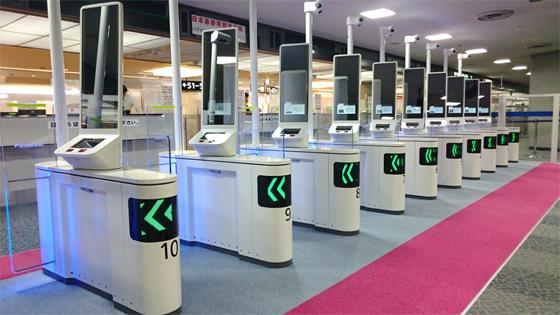
Dec 25, 2025
- Products & Solutions
- Stories
- Technology
- AI & Robotics
- R&D
- Business Solutions
Aug 30, 2019
Products & Solutions / Press Releases
Ministry of Justice expands operation to departure procedures for foreign travelers to
realize fast yet strict immigration control
Osaka, Japan -- Panasonic Corporation announced that it will be providing additional automated facial recognition gates for use at an expanded number of airports in Japan and also for newly expanded use in departure procedures for foreign travelers. The additional order will bring the total number of automated gates to 203 units across the country (123 units to be used for foreign nationals).

Panasonic automated facial recognition gates at immigration examination area in
Narita Airport Terminal 1 Building (South Wing)
In October 2017, Panasonic's automated facial recognition gates were first chosen by the Immigration Services Agency of the Ministry of Justice, and 137 units have since been put into operation at five major airports in Japan (Tokyo Haneda, Tokyo Narita, Nagoya Chubu Centrair, Osaka Kansai, and Fukuoka). For the additional order, beginning at Haneda Airport in Tokyo on July 24, 2019, another 66 units will begin operation at a total of seven airports including Sapporo New Chitose (in mid-November) and Okinawa Naha Airport (in early July 2020).
With Japan aiming to realize its goal of becoming a tourism nation and increasing the number of foreign visitors coming to Japan to 40 million a year by 2020 and 60 million by 2030, various efforts have been made by the Ministry of Justice with the role of immigration to streamline the departure and return procedures for Japanese nationals and the departure procedures for foreign nationals through the use of automated facial recognition gates in order to allocate a greater number of immigration inspectors to the examination procedures for foreign nationals, and to maintain the strictness of the examinations while ensuring greater facilitation. As part of these efforts, starting October 18, 2017, three of Panasonic's facial recognition gate units were first put into operation at the Tokyo Haneda International Airport's immigration control. By 2018, a total of 137 units were in operation at five major airports in Japan. The systems are contributing to fast yet strict immigration procedures for travelers.
Without the need for prior registration of biometric data, the system compares photographic data of the traveler's face in the IC chip embedded in the passport with an image taken at the facial recognition gate to verify identity. According to the Ministry of Justice, approximately 80% of all Japanese travelers use Panasonic's facial recognition gates.
Panasonic's facial recognition gate was designed to streamline departure and return procedures based on the concept of a simple, secure, safe solution where both first-timer users and the elderly can pass through the gate without delay, frustration, or confusion. The gate has the following features: (1) Intuitive usability thanks to the ergonomic design and sophisticated technology the company has developed for passport readers; (2) High performance facial recognition engine with advanced technology that can deal with appearance-altering variations such as aging, makeup, facial expression, and image quality; and (3) Spatial design and overall service design that enable optimum arrangement in a limited space based on field trials.
Furthermore, in order to apply this system to the departure procedures for overseas visitors, Panasonic has been improving the facial recognition engine through field trials in collaboration with the Ministry of Justice.
Panasonic will continue to help authorities implement fast yet strict immigration control procedures at airports and seaports throughout Japan as the country aims to establish itself as a tourism nation toward 2020 and beyond. The company is also working to provide various solutions for users in the private sector by combining its passport and facial recognition technologies. In addition, the company continues to enhance its facial recognition solutions to include systems not only for public agencies but also for private offices and the transport industry to contribute to higher security, safety, and efficiency.
Panasonic has employed various advanced technologies that meet a number of requirements considered necessary to operate the gate properly. They include the advance elimination of factors that can cause false rejections, countermeasures against unauthorized entry, and a high-performance facial recognition engine. To improve usability, Panasonic has also achieved the following features through research and field trials in collaboration with external research institutes such as universities.
For further information on usage guide and restrictions, please see:
http://www.moj.go.jp/ENGLISH/m_nyuukokukanri07_00016.html
The content in this website is accurate at the time of publication but may be subject to change without notice.
Please note therefore that these documents may not always contain the most up-to-date information.
Please note that German, Spanish and Chinese versions are machine translations, so the quality and accuracy may vary.